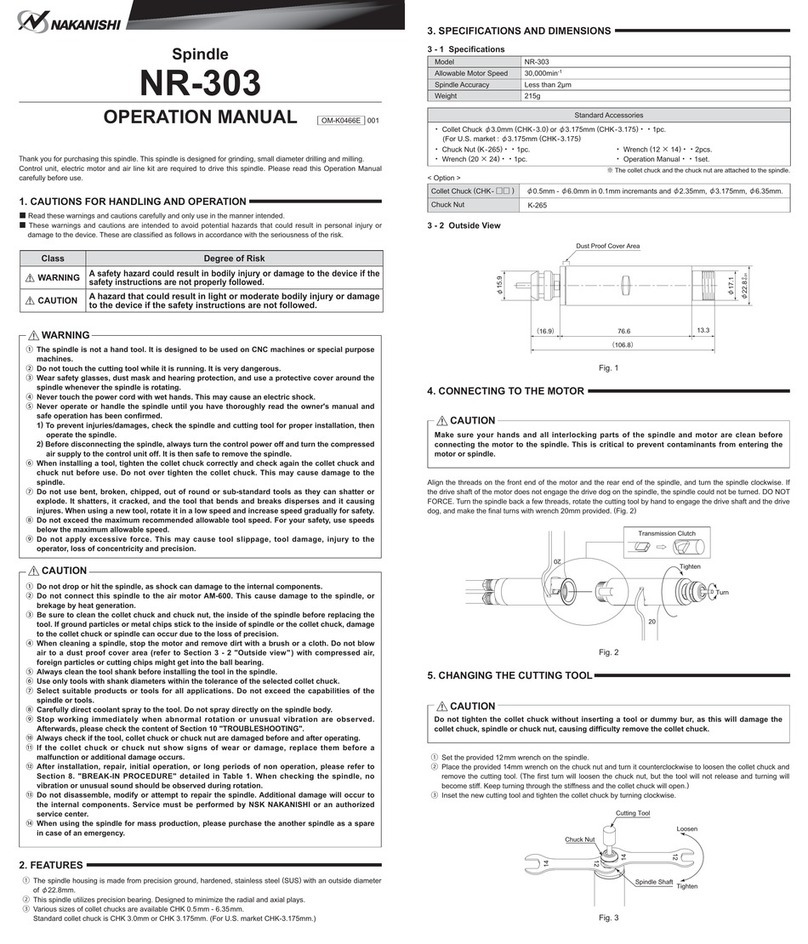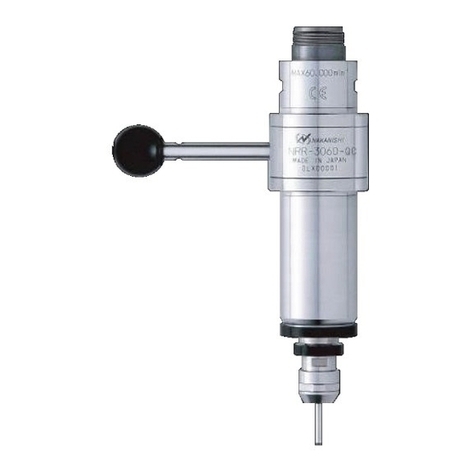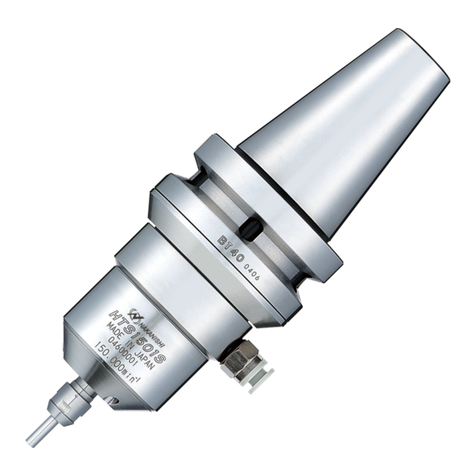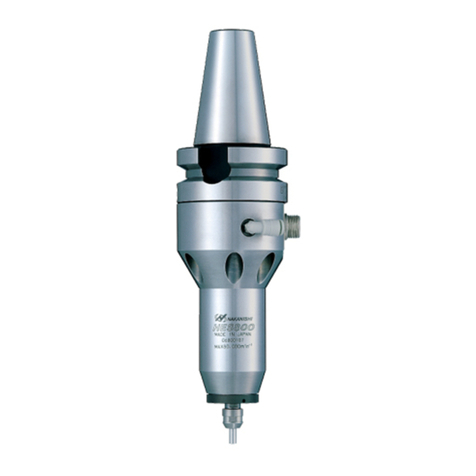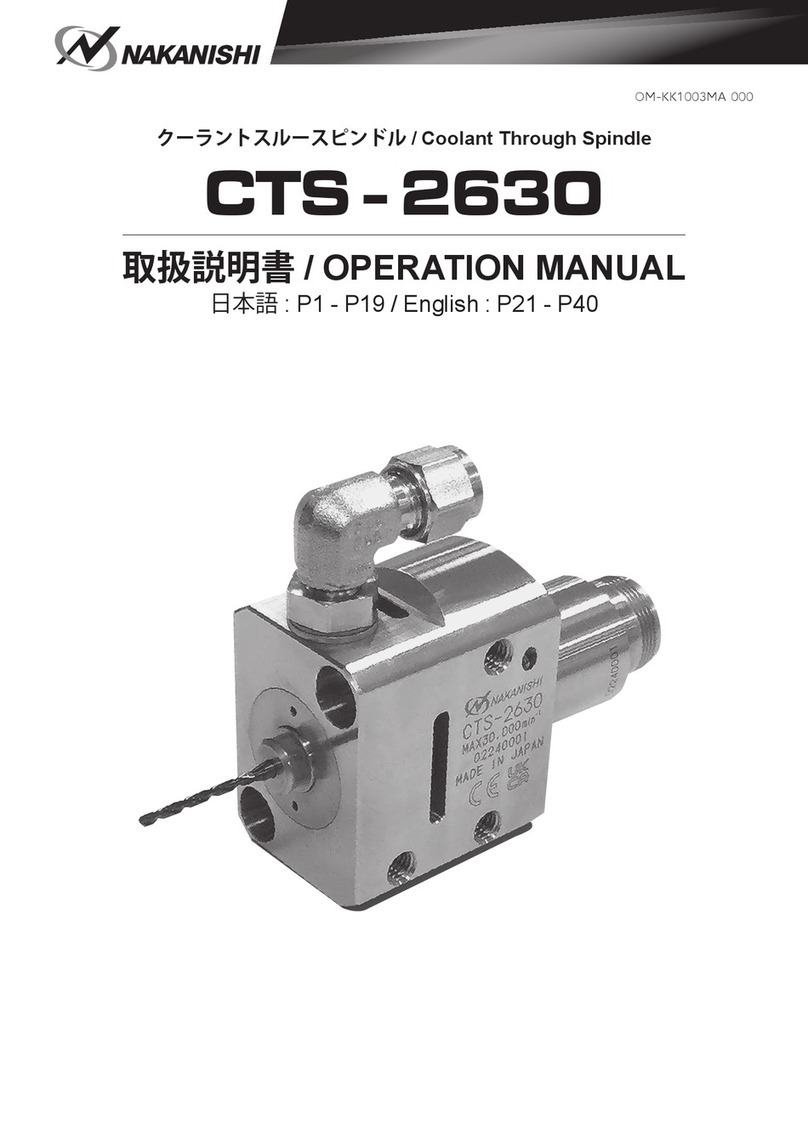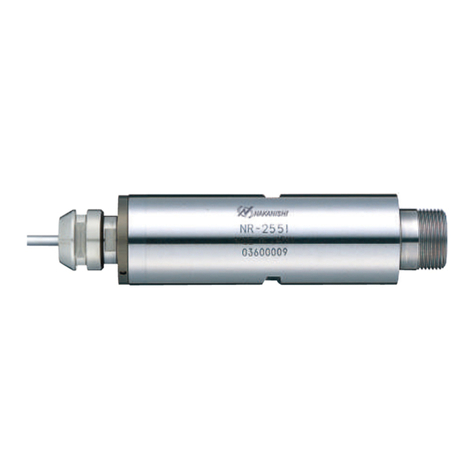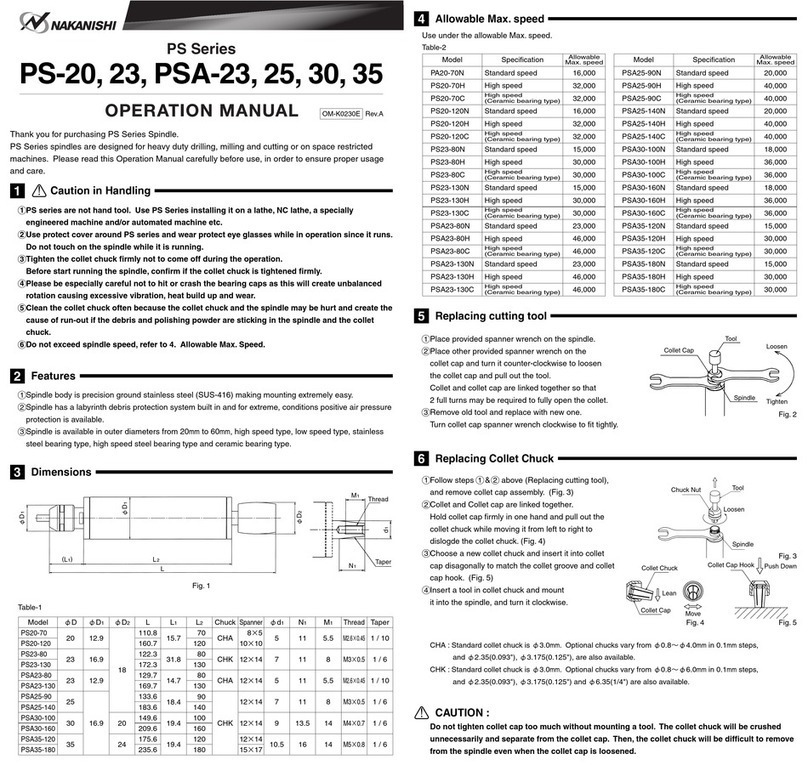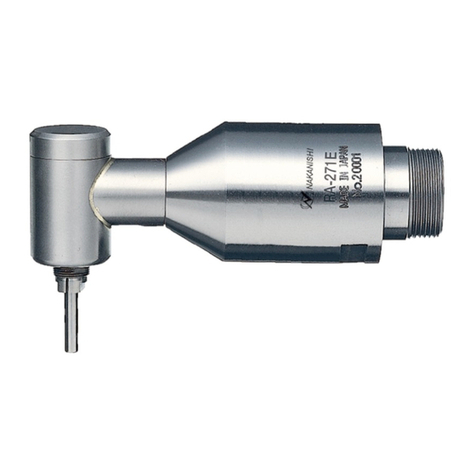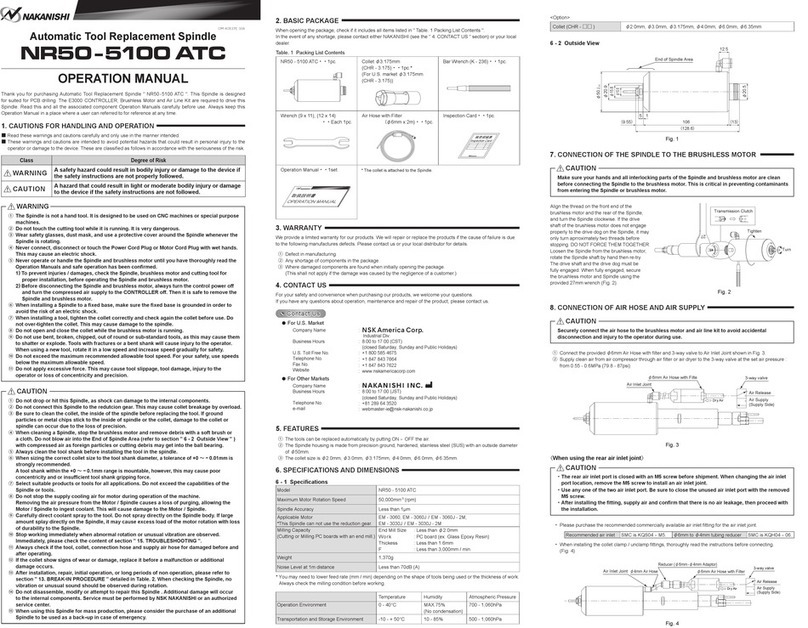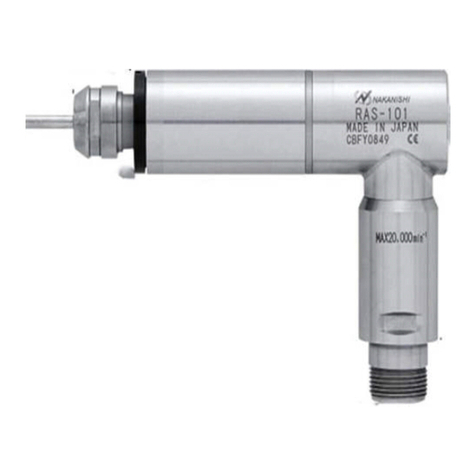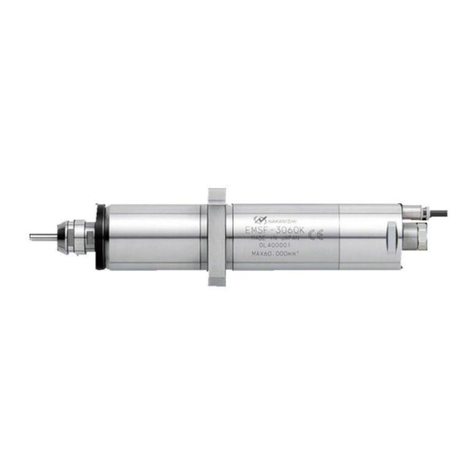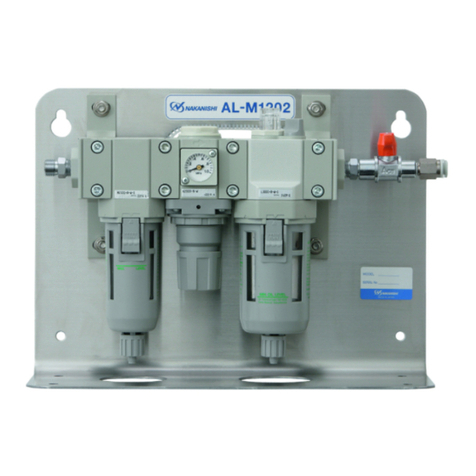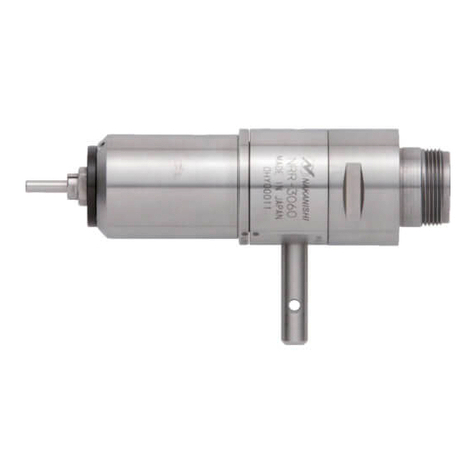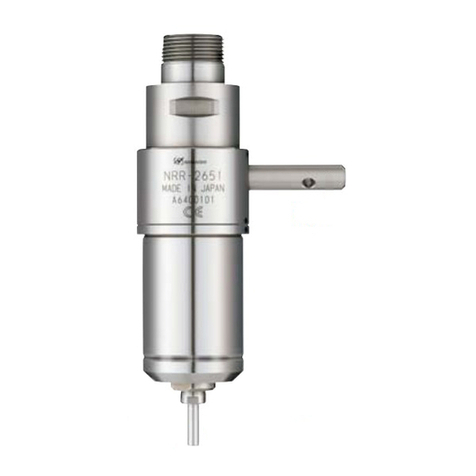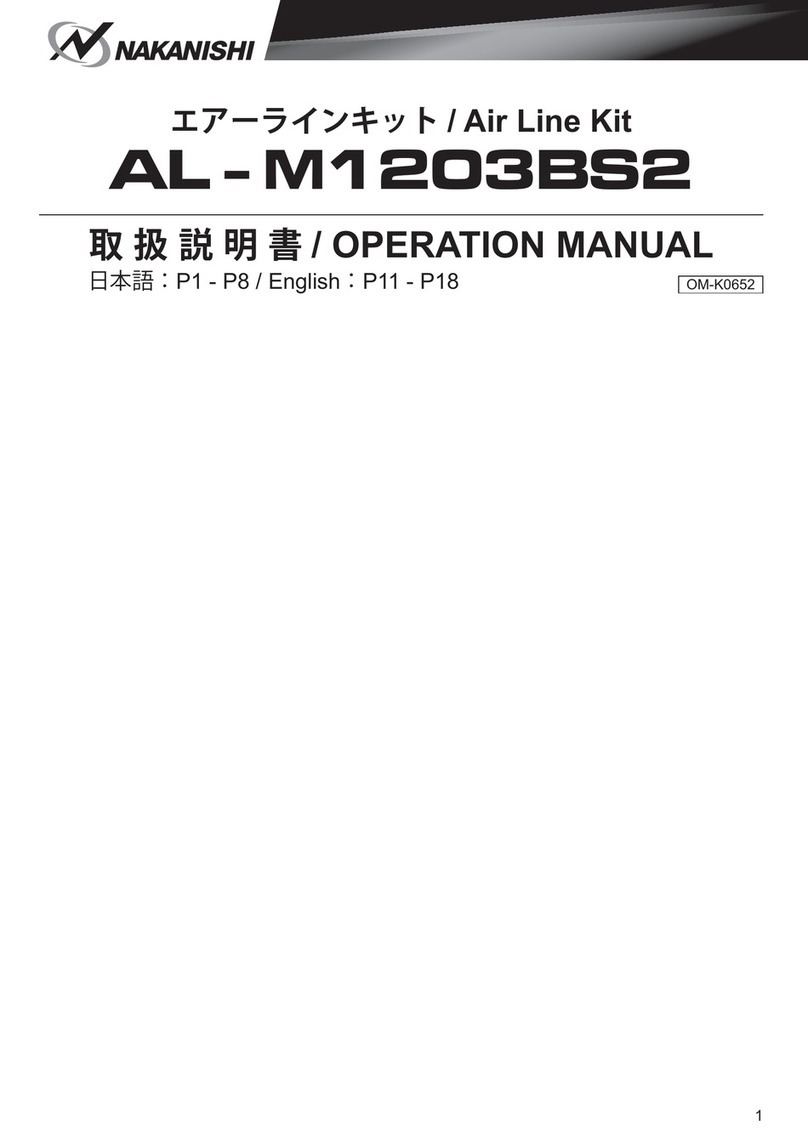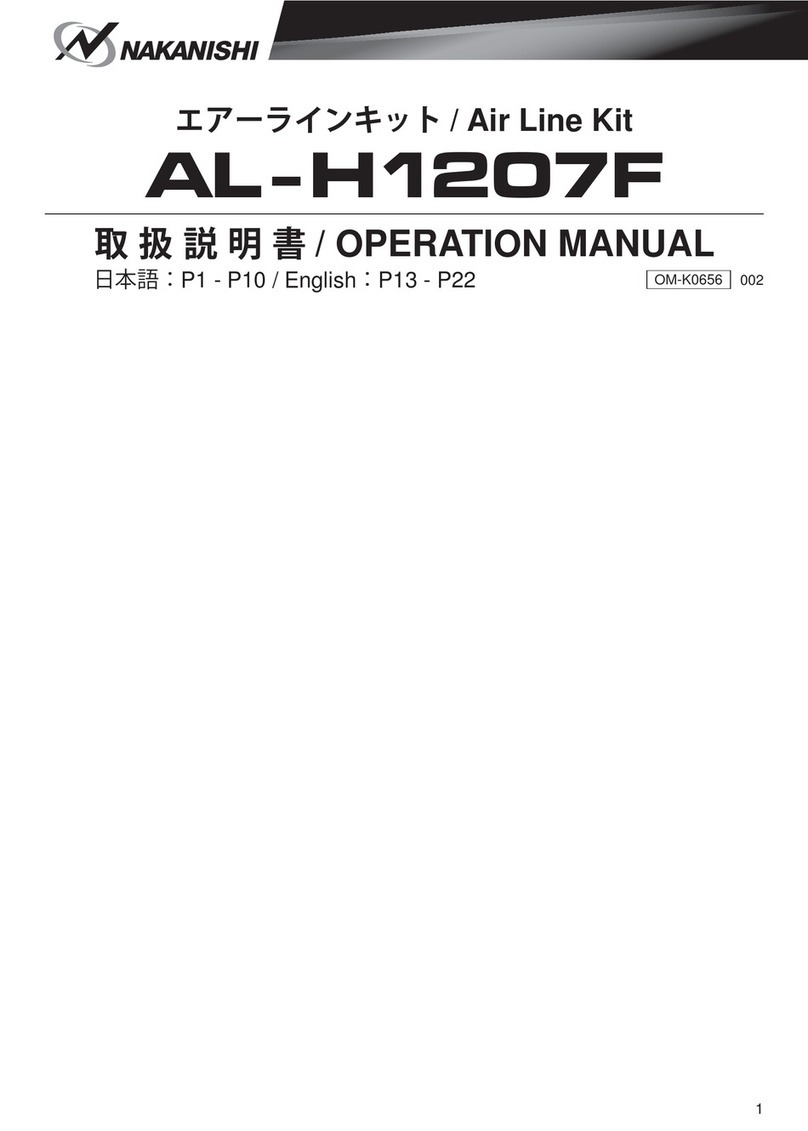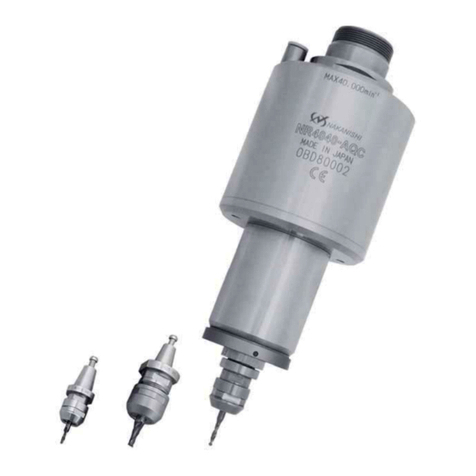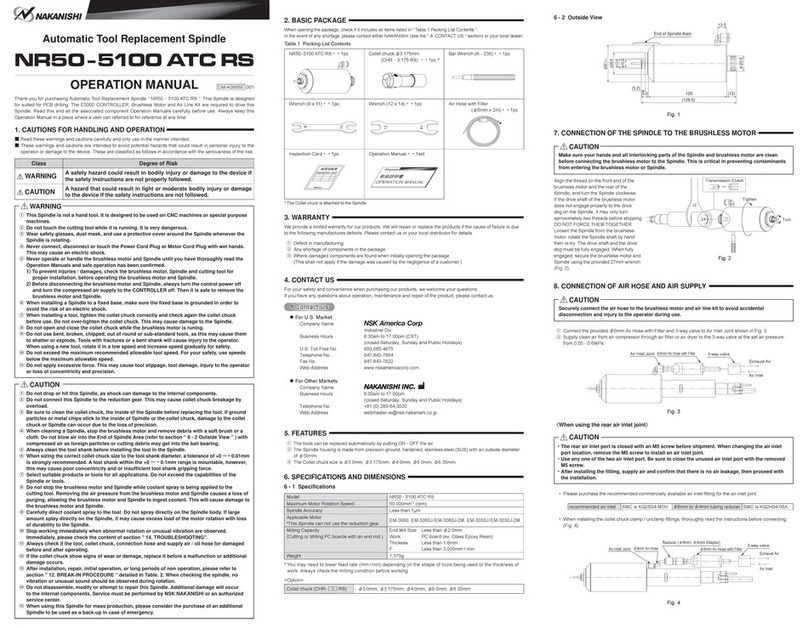
REPLACING THE COLLET CHUCK8.
When installing the collet chuck into the chuck nut, be sure to fully engage the latch inside the chuck
nut to the groove on the collet chucks outer diameter area. In addition, remember that if the collet
chuck is attached without being engaged with the latch of the chuck nut, the collet chuck cannot be
removed and this may cause damage to the collet chuck or the spindle.
CAUTION
①Remove the tool according to the section " 7. CHANGING THE TOOL " procedure above and remove chuck
nut assembly (Fig. 7).
②The collet chuck and chuck nut are secured by a groove in the collet chuck and a ange in the chuck nut. To
remove the collet chuck hold the chuck nut in one hand and push diagonally down on the collet chuck. The
collet chuck should be released (Fig. 8).
③To install the collet chuck, hold the collet chuck at a slight angle, and insert it into the chuck nut (Fig. 9).
Press the collet chuck in the chuck nut by positioning the collet chuck in the chuck nut and pressing down on
at surface (Fig. 8).
Be sure to fully engage the latch inside the chuck nut into the groove on the collet chuck's outer circumference
area (Fig. 10).
Latch
Chuck Nut
Collet Chuck
Groove
Latch
Chuck Nut
DOWN
Collet Chuck
Wrench Seat
Spindle Shaft
Loosen
Chuck Nut
Tool
Fig. 7
Fig. 9
Fig. 8
Fig. 10
CONNECTION OF MOTOR CORD9.
・Before connecting to the Motor Cord to the Motor and CONTROLLER, verify the Main Power
Switch in the CONTROLLER is turned OFF. If the Main Power Switch on the CONTROLLER is ON
while connecting the Motor Cord, damage to the CONTROLLER is possible.
・Install the Protective Cap etc. to prevent damage or contamination to the Motor Cord Plug when
not in use.
CAUTION
①Remove the Protective Cap of the Motor Cord.
②Carefully insert the alignment pin into the alignment hole and push straight into the Connector of the Motor
Cord.
③Tighten the Connector Nut with clockwise.
Motor Cord Side
Motor Cord PlugAlignment HoleAlignment Pin
Motor Spindle Side
Motor Connector
Take Out
Protective Cap
Motor Spindle Side Motor Cord Side
Connector Nut
Tighten
Fig. 11
Fig. 12
Fig. 13
INSTALLATION OF THE MOTOR SPINDLE10.
When installing a Motor Spindle to a xed base, make sure the xed base is grounded in order to avoid the risk of
an electric shock.
WARNING
・When installing a Motor Spindle, do not hit, drop or cause shock to the Motor Spindle. This may
cause damage to internal components and result in malfunctions.
・When mounting the Motor Spindle, be sure to secure within Clamping Area etched on the Motor
Spindle O.D. If the Motor Spindle is installed incorrectly, damage to the internal components is
possible.
・Cautions when tightening the securing bolts on to a Split Type Holder
Do not over-tighten the bolt. This will cause damage to Motor Spindle's ecision.
Tighten the bolt until the Motor Spindle body can not be rotated by hand within the xture.
Extreme tightening is not necessary or recommended.
Apply working force and check that the Motor Spindle is tight before using.
CAUTION
①When mounting a Motor Spindle, refer to the Clamping Area etched on the Motor Spindle (Fig. 14).
Model D1 D2
EM20 - S6000 18 34
EM25 - S6000 22 30
EM30 - S6000 20 36
Table. 2
CLAMPING AREA
D2
(Recommended)
D1
Fig. 14
* When installing a EM30 - S6000, using " Grip Ring GR
- 30 (sold separately) " (Fig. 15) is recommended. If the
Grip Ring GR - 30 (sold separately) cannot be used due
to the restriction of dimension and space, and when
installing a EM25 - S6000 / EM20 - S6000, install as
shown in ②below.
EA
Grip Ring GR-30
(Sold separately)
Fig. 15
②When installing a Motor Spindle to the holder, recommended installation method is shown Fig. 16. Refer to " ③
How to fabricate the Split Type Holder ".
If this is not possible, install as shown in Fig. 17.
Fastening Bolt
Bushing with Slit
Slit of Bushing
Fastening Bolt
Split type Holder
Spacer
Slit
Fastening Bolt
Fig. 16 Fig. 18Fig. 17
Do not allow set screws to come directly in contact with the Motor Spindle body as shown in Fig. 18, as
this will result in damage to the Motor Spindle housing and internal components.
When installing, never clamp directly over the bearings, as this will result in bearing damage (Refer to
Fig. 19).
CAUTION
Damage of lnternal
Components
Deformation
Bearing
Fastening Bolt
Fig. 19
Model EM20 - S6000 EM25 - S6000 EM30 - S6000
Motor Spindle's outside diameter ȭ20 ȭ25 ȭ30
Table. 3
・How to conrm the correct tightening or clamping of the Motor Spindle in the holder
Measure the current value of the CONTROLLER's power cord by the clamp meter.
Fasten the holder so that the increase in the no-load current value (during rotation at the maximum
rotation speed) with the Motor Spindle fastened is 20mA (for type 120V) / 10mA (for type 200V /
230V) or less, compared to the no-load current value (during rotation at the maximum rotation
speed) without fastening the Motor Spindle. Do not over-tighten the Fastening Bolt. It may damage
Motor Spindle's precision and shorten the life of the bearings.
・The nal responsibility for ensuring holderʼs safety for use in a given application is left to the
designer of the equipment in which NAKANISHI's Motor Spindle is installed.
NAKANISHI offers Motor Spindle with a wide variety of capabilities and specications.
Please carefully check the Motor Spindle's specications against the requirements of your
equipment and verify suitability and safety of the Holder prior to initial use.
CAUTION
BREAK-IN PROCEDURE
11.
During transportation, storage or installation, the grease inside the bearings will settle. If the Motor Spindle is
suddenly run at high-speed, the grease will be ejected from the bearings, causing excessive heat that will cause
bearing damage.
After installation, repair, initial operation, or long periods of non operation, please follow the break-in procedure
detailed in Table 4.
Table. 4
Steps 12345
Rotation Speed
(min-1) (rpm) 15,000 30,000 40,000 50,000 60,000
Rotation Time
(min) 15 10 10 10 10
Items to Check
No Abnormal
Noises
The Motor Spindle housing temperature during the
break-in process should not exceed 20 degrees C
(36 degrees F) above ambient temperature. Should
the Motor Spindle exceed this limit, rest the Motor
Spindle for at least 20 minutes and re-start the break
in procedure from the beginning. If the housing
temperature rises again and exceeds 20 degrees C
(36 degrees F) above ambient temperature, check the
spindle and motor for proper installation.
The Motor
Spindle housing
temperature
during the
break-in process
should not
exceed 20
degrees C (36
degrees F)
above ambient
temperature.
CAUTIONS WHEN USING GRINDSTONES AND TOOLS12.
The maximum surface speed or rpm is always specied for a grindstone. Do not exceed the maximum
speed with reference to the calculating chart below. Always follow the grindstone manufacturer's
recommendations.
3.14 x Diameter (mm) x Rotation Speed (min-1) (rpm)
Surface Speed (m / s) = 1,000 x 60
CAUTION
①The proper surface speed for general grindstones is 10 - 30m / s.
②Do not exceed 13mm of overhang for mounted grindstones as shown in Fig. 21. If the overhang must exceed
13mm, reduce the motor speed in accordance with Table. 5.
③Dress the grindstone prior to use.
④Do not use cutting tools with bent or broken shanks, cracks or excessive run-out.
⑤For grinding, the maximum depth of cut should not exceed 0.01mm radially or axially. Reciprocate the tool
several times after each pass to eliminate tool pressure.
⑥Always operate cutting tools within the allowable recommended speed of the cutting tools. Use of a cutting
tool outside of the allowable speed of the cutting tools could cause damage to the spindle and injury to the
operator.
⑦Keep the cutting tool shank and collet chuck clean. If contaminants are left in the collet chuck or chuck nut,
excessive run-out will cause damage to the cutting tool and or spindle.
⑧Do not strike or disassemble the Motor Spindle.
⑨Please set the cutting tools to minimize the overhang amount. 13mm is the maximum amount of
overhang to maintain high accuracy and safety.
* N = Max. Operating Speed with 13mm overhang.
Overhang (mm) Max. Speed (min-1) (rpm)
20 N x 0.5
25 N x 0.3
50 N x 0.1
Table. 5 Overhang and Speed
13
Fig. 21
Front View
Spacer
Slit
Fastening Bolt
Side View
Spacer
Fastening Bolt
Screw for Removal
Spacer
Fastening Bolt
Screw for Removal
Fig. 20
TROUBLESHOOTING13.
If a problem or concern occur, please check the following items prior to consulting your dealer.
Trouble Cause Inspection / Corrective Action
Motor Spindle does not
rotate or rotate smoothly.
The Motor Spindle ball bearings
have been damaged.
Replace the ball bearings.
(Return to NAKANISHI dealer service.)
The motor has been damaged. Replace the motor.
(Return to NAKANISHI dealer service.)
Overheating during
rotation.
Cutting debris has contaminated the
ball bearings, and the ball bearings
are damaged.
Replace the ball bearings.
(Return to NAKANISHI dealer service.)
Low air pressure. Check air hose connection and air pressure.
Abnormal vibration or
noise during rotation.
The tool shank is bent. Replace the tool.
Cutting debris has contaminated the
ball bearing.
Replace the ball bearings.
(Return to NAKANISHI dealer service.)
The Motor Spindle ball bearings
have been damaged.
Tool slippage. Collet chuck or chuck nut are not
correctly installed.
Check and clean the collet chuck and chuck
nut. Reinstall the collet chuck and chuck nut.
The collet chuck and the chuck nut
are worn.
Replace the collet chuck and chuck nut.
High run-out. The tool is bent. Change the tool.
Chuck nut is not correctly installed. Secure the collet chuck and the chuck nut
correctly.
The collet chuck and the chuck nut
are worn.
Replace the collet chuck and the chuck nut.
Inside of the spindle is worn. Replace the spindle shaft.
(Return to NAKANISHI dealer service.)
Contaminants inside the collet
chuck and the chuck nut or the
spindle.
Clean the collet chuck, chuck nut and the inside
of the taper and spindle.
The Motor Spindle ball bearings
have been damaged.
Replace the ball bearings.
(Return to NAKANISHI dealer service.)
Refer to the E3000 CONTROLLER Operation Manual.
DISPOSAL OF THE MOTOR SPINDLE14.
When disposal of a Motor Spindle is necessary, follow the instructions from your local government agency for
proper disposal of industrial components.
Contents are subject to change without notice.
2015.01.20 003
③How to fabricate the Split Type Holder
(1) Rough bore the inside diameter of the Split Type Holder.
(2) Cslit. (Ex. Slit 2mm) wide.
(3) Tighten the Screw for Removal and Force Open the Slit Area.
(4) Iacer (Ex. thickness = 2mm) into the Slit Area.
(5) Loosen the Screw for Removal, and tighten the fastening bolt with its specied torque.
(6) Finish the Split Type Holder so that the inside diameter of the Split Type Holder is Motor Spindle's
outside diameter (Refer to Table 3). The correct tolerance range for the holder is
-
0.01mm to
-
0.015mm and a roundness and cylindricity of less than 5m.
(7) When inserting the Motor Spindle loosen the Fastening Bolt, and tighten the Screw for Removal,
widening the Slit Area.
